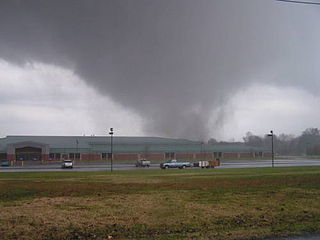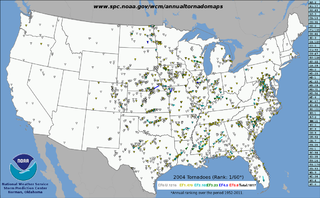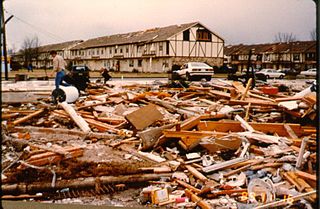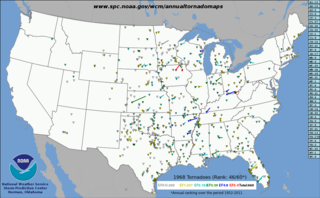
The 1974 Super Outbreak was the second-largest tornado outbreak on record for a single 24-hour period, just behind the 2011 Super Outbreak. It was also the most violent tornado outbreak ever recorded, with 30 F4/F5 tornadoes confirmed. From April 3–4, 1974, there were 148 tornadoes confirmed in 13 U.S. states and the Canadian province of Ontario. In the United States, tornadoes struck Illinois, Indiana, Michigan, Ohio, Kentucky, Tennessee, Alabama, Mississippi, Georgia, North Carolina, Virginia, West Virginia, and New York. The outbreak caused roughly $843 million USD in damage, with more than $600 million occurring in the United States. The outbreak extensively damaged approximately 900 sq mi (2,331 km2) along a total combined path length of 2,600 mi (4,184 km). At one point, as many as 15 separate tornadoes were occurring simultaneously.

The Great Natchez tornado hit Natchez, Mississippi, on Thursday, May 7, 1840. The tornado was the second-deadliest tornado in United States history; at least 317 people were killed and at least 109 were injured. While officially unrated, it is retrospectively estimated to have been an extremely violent F5 tornado on the Fujita scale. Its 35-mile-long (56 km), 1,000-yard-wide path was marked by severe damage and uncertain estimates of casualties, though many enslaved Africans—possibly numbering in the hundreds—reportedly died on plantations in Louisiana.

Hurricane Ivan was a large, long-lived, Cape Verde hurricane that caused widespread damage in the Caribbean and United States. The cyclone was the ninth named storm, the sixth hurricane and the fourth major hurricane of the active 2004 Atlantic hurricane season.

Hurricane Danny produced 13 significant (F2+) tornadoes in the Southern United States during August 1985, the most spawned by a tropical cyclone until Hurricane Ivan in 2004. The fourth named storm and third hurricane of the season, Danny developed from a tropical wave in the northwestern Caribbean Sea on August 12. The system moved northwestward and initially remained weak. Early on August 13, it brushed Cape San Antonio, Cuba before emerging the Gulf of Mexico later that day. The system then intensified into Tropical Storm Danny on August 14. Danny deepened further and became a hurricane early on the following day, while beginning to re-curve north-northwestward. Late on August 16, Danny attained its peak intensity with winds of 90 mph (150 km/h). Shortly thereafter, the storm made landfall near Grand Chenier, Louisiana at the same intensity. Early on August 17, Danny weakened to a tropical storm and was downgraded to a tropical depression several hours later. It moved east-northeastward across the Southeastern United States, until dissipating over southeastern Virginia on August 18.

This page documents notable tornadoes and tornado outbreaks worldwide in 2005. Strong and destructive tornadoes form most frequently in the United States, Bangladesh, Argentina, Brazil and Eastern India, but they can occur almost anywhere under the right conditions. Tornadoes also develop occasionally in southern Canada during the Northern Hemisphere's summer and somewhat regularly at other times of the year across Europe, Asia, and Australia. Tornadic events are often accompanied with other forms of severe weather, including strong thunderstorms, strong winds, and hail.

This page documents notable tornadoes and tornado outbreaks worldwide in 2004. Strong and destructive tornadoes form most frequently in the United States, Bangladesh, and Eastern India, but they can occur almost anywhere under the right conditions. Tornadoes also develop occasionally in southern Canada during the Northern Hemisphere's summer and somewhat regularly at other times of the year across Europe, Asia, and Australia. Tornadic events are often accompanied with other forms of severe weather, including strong thunderstorms, strong winds, and hail.
On March 16–17, 1942, a deadly late-winter tornado outbreak struck a large area of the Central and Southern United States, killing 149 people and injuring at least 1,312. At least five states reported violent tornadoes, from Illinois and Indiana south to Mississippi, beginning with an F4 tornado in the morning in Illinois. Intense activity spread south to the Gulf Coast and north to the Michigan–Indiana border as the day went on. Seven violent tornadoes were reported, one of which was a powerful F5 in Illinois. A long-tracked F4 tornado family in Mississippi claimed 63 lives as well, becoming the deadliest event of the outbreak. Another long-lived F4 in Tennessee killed 15 more people, and a series of intense tornadoes caused 24 other deaths in Kentucky. The outbreak also produced 18 tornadoes that caused at least one death—ranking eighth on a list of similar events since 1880 by tornado researcher Thomas P. Grazulis.

This page documents the tornadoes and tornado outbreaks of 1999, primarily in the United States. Most tornadoes form in the U.S., although some events may take place internationally, particularly in parts of neighboring southern Canada during the Northern Hemisphere's summer season, as well as Europe. One particular event, the Bridge Creek-Moore, Oklahoma F5 tornado, produced the highest wind speed ever recorded on Earth, which was 301 ± 20 mph (484 ± 32 km/h).

This page documents the tornadoes and tornado outbreaks of 1989, primarily in the United States. Most tornadoes form in the U.S., although some events may take place internationally. Tornado statistics for older years like this often appear significantly lower than modern years due to fewer reports or confirmed tornadoes.

This page documents the tornadoes and tornado outbreaks of 1992, primarily in the United States. Most tornadoes form in the U.S., although some events may take place internationally. Tornado statistics for older years like this often appear significantly lower than modern years due to fewer reports or confirmed tornadoes, however by the 1990s tornado statistics were coming closer to the numbers we see today.

The 2011 Super Outbreak was the largest, costliest, and one of the deadliest tornado outbreaks ever recorded, taking place in the Southern, Midwestern, and Northeastern United States from April 25 to 28, 2011, leaving catastrophic destruction in its wake. Over 175 tornadoes struck Alabama, Mississippi, and Tennessee, which were the most severely damaged states. Other destructive tornadoes occurred in Arkansas, Georgia, Kentucky, Louisiana, New York, and Virginia, with storms also affecting other states in the Southern and Eastern United States. In total, 360 tornadoes were confirmed by NOAA's National Weather Service (NWS) and Government of Canada's Environment Canada in 21 states from Texas to New York to southern Canada. Widespread and destructive tornadoes occurred on each day of the outbreak. April 27 was the most active day, with a record 216 tornadoes touching down that day from midnight to midnight CDT. Four of the tornadoes were rated EF5, which is the highest ranking on the Enhanced Fujita scale; typically these tornadoes are recorded no more than once a year.

This page documents the tornadoes and tornado outbreaks of 1968, primarily in the United States. Most tornadoes form in the U.S., although some events may take place internationally. Tornado statistics for older years like this often appear significantly lower than modern years due to fewer reports or confirmed tornadoes. Two F5 tornadoes struck Iowa in the Charles City and Maynard areas, combined they claimed 18 lives and this was one of very few cases in history where two F5 or EF5 tornadoes hit the same state, on the same day.

This page documents the tornadoes and tornado outbreaks of 1964, primarily in the United States. Most tornadoes form in the U.S., although some events may take place internationally. Tornado statistics for older years like this often appear significantly lower than modern years due to fewer reports or confirmed tornadoes.

This page documents notable tornadoes and tornado outbreaks worldwide in 2020. Strong and destructive tornadoes form most frequently in the United States, Argentina, Brazil, Bangladesh, and eastern India, but can occur almost anywhere under the right conditions. Tornadoes also develop occasionally in southern Canada during the Northern Hemisphere's summer and somewhat regularly at other times of the year across Europe, Asia, Argentina, Australia and New Zealand. Tornadic events are often accompanied by other forms of severe weather, including strong thunderstorms, strong winds, and hail. There were 1,243 preliminary filtered reported tornadoes in 2020 in the United States in 2020, and 1,086 confirmed tornadoes in the United States in 2020. Worldwide, at least 93 tornado-related deaths were confirmed with 78 in the United States, eight in Vietnam, two each in Canada, Indonesia, and Mexico, and one in South Africa.

A widespread and deadly tornado outbreak affected the Southeastern United States on Easter Sunday and Monday, April 12–13, 2020. Several tornadoes were responsible for prompting tornado emergencies, including the first one to be issued by the National Weather Service in Charleston, South Carolina. A large squall line formed and tracked through the mid-Atlantic on April 13, prompting more tornado warnings and watches. A total of 15 watches were produced during the course of the event, two of which were designated Particularly Dangerous Situations.

This page documents the tornadoes and tornado outbreaks of 1954, primarily in the United States. Most tornadoes form in the U.S., although some events may take place internationally. Tornado statistics for older years like this often appear significantly lower than modern years due to fewer reports or confirmed tornadoes.

This page documents the tornadoes and tornado outbreaks of 1953, primarily in the United States. Most tornadoes form in the U.S., although some events may take place internationally. Tornado statistics for older years like this often appear significantly lower than modern years due to fewer reports or confirmed tornadoes. This was the first year to record an F5 tornado as well as one of the deadliest tornado seasons in official U.S. records, which go back to 1950.
This page documents the tornadoes and tornado outbreaks of 1948, primarily in the United States. Most tornadoes form in the U.S., although some events may take place internationally. Tornado statistics for older years like this often appear significantly lower than modern years due to fewer reports or confirmed tornadoes. Also, prior to 1950, tornadoes were not officially surveyed by the U.S. Weather Bureau, which would later become the National Weather Service, and thus had no official rating. All documented significant tornadoes were instead given unofficial ratings by tornado experts like Thomas P. Grazulis.
This page documents the tornadoes and tornado outbreaks of 1946, primarily in the United States. Most recorded tornadoes form in the U.S., although some events may take place internationally. Tornado statistics for older years like this often appear significantly lower than modern years due to fewer reports or confirmed tornadoes.

This is a list of notable tornadoes and tornado outbreaks worldwide in 2023. Strong, destructive tornadoes form most frequently in the United States, Argentina, Brazil, Bangladesh and East India, but can occur almost anywhere. Tornadoes develop occasionally in southern Canada during the Northern Hemisphere's summer, and at other times of the year across Europe, Asia, Argentina, Australia and New Zealand. They are often accompanied by other forms of severe weather, including thunderstorms, strong winds, and large hail. Worldwide, 116 tornado-related deaths were confirmed – 83 in the United States, 12 in China, nine in Indonesia, eight in Myanmar, three in Turkey, and one in Saudi Arabia.

















